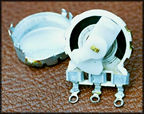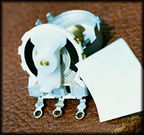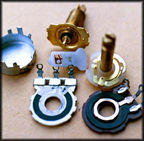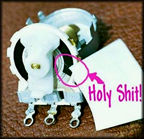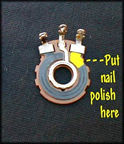
From left to right these pots are a recent Gibson regular length shaft pot typical of what has been in the recent Historic Les Pauls, a recent Gibson long length shaft pot typical of what has been in the recent regular production Les Pauls, a CTS made AllParts regular length shaft pot AllParts number EP086, a CTS made AllParts long length shaft pot AllParts number EP686, and CTS made for Gibson long shaft pot from the mid 1990s.
Click on Images to Enlarge

From left to right, recent Gibson short shaft, AllParts CTS short shaft, recent Gibson long shaft, AllParts CTS long shaft, CTS made for Gibson long shaft. Note some of the differences, the AllParts CTS short shaft has a top portion that is some kind of cast metal instead of a piece of stamped steel. The AllParts CTS pots have what appears to be an aluminum shaft, as opposed to the brass shaft of the older CTS made for Gibson. I inquired to AllParts about the shafts, they couldn't tell me much. It could be a cost reduction or maybe for saving weight. Note that the CTS short shaft and CTS made for Gibson pots have the four metal tabs bent up to allow the pot to be disassembled. Note that when comparing the AllParts and recent Gibson short shafts, the AllPart CTS pot has a small extra portion at the end beyond the knurling. Someone noticed that if replacing just the two volume pots in an Historic LesPaul, the knobs ended up sitting up just a bit higher than the original Gibsons due to this little extra at the end of the shaft. I recently installed two such pots in a friend's Historic, but I prepared them ahead of time by taking them to a bench power grinder and removed that extra 1/16 or so grinding the end of the shaft level with the knurling.
Click on Images to Enlarge
